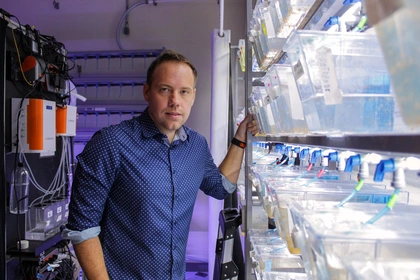Recent research guided by Carnegie’s Phillip Cleves employs innovative CRISPR/Cas9 genome editing tools to unravel a gene that is vital for stony corals’ capability to build reef architectures.

Phillip Cleves at work in Carnegie’s coral research facility in Baltimore. Carnegie researchers have been leading efforts to apply biomedical techniques to pressing environmental issues, including coral bleaching and ocean acidification. Image Credit: Navid Marvi courtesy of the Carnegie Institution for Science
The study was published in the Proceedings of the National Academy of Sciences.
Stony corals, marine invertebrates, build large skeletons. These huge skeletons form the basis of reef ecosystems. A quarter of all known marine species live in these biodiversity hotspots.
Coral reefs have tremendous ecological value. But they are in decline due to human activity. Carbon pollution that we spew into the air is both warming oceans—causing fatal bleaching events—and altering seawater chemistry—resulting in ocean acidification that impedes reef growth.
Phillip Cleves, Carnegie Institution for Science
Excess carbon dioxide emitted into the atmosphere by the combustion of fossil fuels is absorbed by the ocean. It combines with water to form an acid that is corrosive to coral, shellfish, and other marine organisms.
Stony corals are susceptible to ocean acidification because they build their skeletons by the accretion of calcium carbonate, a process known as calcification, which becomes more difficult as the pH of the surrounding water lowers. Because of the significance of coral skeleton development in reef formation, understanding the genes that drive the process and how it has evolved in corals has been a major research focus.
Cleves’ lab has been using the Nobel Prize-winning CRISPR/Cas9 technology for several years to find cellular and molecular pathways that could assist in guiding coral conservation and rehabilitation initiatives. They previously discovered a gene that is crucial to how a coral responds to heat stress, which could help anticipate how corals would adapt to future bleaching events.
Cleves’ group—which included Carnegie’s Amanda Tinoco—employed genome editing tools to identify that a specific gene, called SLC4γ, is vital for young coral colonies to start developing their skeletons. It encodes a protein that transports bicarbonate across cellular membranes. Notably, SLC4γ is found only in stony corals but not in their non-skeleton-forming relatives. These findings suggest that stony corals evolved skeleton development using the novel gene SLC4γ.
By applying cutting-edge molecular biology techniques to pressing environmental problems, we can reveal the genes that determine ecologically important traits. In developing these genetic tools to study coral biology, we can greatly improve our understanding of their biology and learn how to mount successful conservation efforts for these fragile communities.
Phillip Cleves, Carnegie Institution for Science
Cleves was chosen earlier this year by The Pew Charitable Trusts as one of seven recipients of the 2023 Pew Fellowship in Marine Conservation and the organization’s inaugural Marine and Biomedical Science Fellowship. This initiative funds studies that leverage approaches or technologies more frequently seen in biomedical science to improve marine conservation.
Carnegie’s Lorna Mitchison-Field, Jacob Bradford and Dimitri Perrin of Queensland University of Technology, Christian Renicke and John Pringle of Stanford University, and Line Bay of the Australian Institute of Marine Science contributed to the research.
The research was supported by start-up funds from the Carnegie Institution for Science, an International Macquarie University Research Excellence Scholarship, an Australian Institute for Marine Science internal grant, an NSF-IOS EDGE grant, and a Simons Foundation grant.
Journal Reference
Tinoco, A. I., et al. (2023) Role of the bicarbonate transporter SLC4γ in stony-coral skeleton formation and evolution. Proceedings of the National Academy of Sciences. doi.org/10.1073/pnas.2216144120.